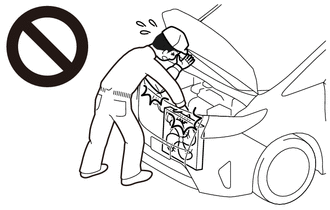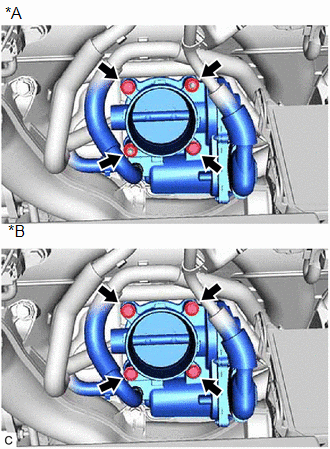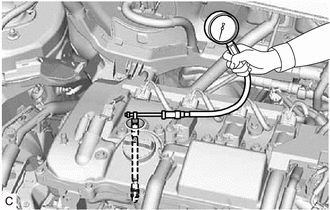-
Faulty ignition:
- Incorrect valve timing
- Fouled, shorted or improperly gapped spark plugs
- Incorrect valve clearance (valve lash adjuster assembly)
- Leaks in intake or exhaust valves
- Leaks in cylinders
- Faulty EGR
| Last Modified: 05-13-2024 | 6.11:8.1.0 | Doc ID: RM100000001GMHI |
| Model Year Start: 2020 | Model: Corolla | Prod Date Range: [01/2019 - ] |
| Title: 2ZR-FXE (ENGINE MECHANICAL): ENGINE: ON-VEHICLE INSPECTION; 2020 - 2025 MY Corolla Corolla HV [01/2019 - ] | ||
ON-VEHICLE INSPECTION
CAUTION / NOTICE / HINT
CAUTION:
To prevent injury due to contact with an operating cooling fan, keep your hands and clothing away from the cooling fans when working in the engine compartment with the engine running or the power switch on (IG).

PROCEDURE
1. INSPECT COOLANT (for Engine)
2. INSPECT ENGINE OIL
3. CHECK AUXILIARY BATTERY
4. INSPECT SPARK PLUG
5. INSPECT AIR CLEANER FILTER ELEMENT SUB-ASSEMBLY
6. INSPECT VALVE LASH ADJUSTER ASSEMBLY NOISE
(a) Put the engine in inspection mode.
(b) Rev up the engine several times. Check that the engine does not emit unusual noises.
(c) If unusual noises occur, warm up the engine and idle it for 30 minutes or more, then perform the inspection.
HINT:
If any defects or problems are found during the inspection, perform valve lash adjuster assembly inspection.
7. INSPECT IGNITION TIMING
NOTICE:
- Check the ignition timing with the cooling fans off.
- Turn off all electrical systems and the A/C.
- When checking the ignition timing, the transaxle should be in park.
(a) Put the engine in inspection mode.
(b) Warm up and stop the engine.
(c) Connect the Techstream to the DLC3.
(d) Put the engine in inspection mode.
(e) Enter the following menus: Powertrain / Engine / Data List / Ignition Timing Cylinder #1.
Powertrain > Engine > Data List
|
Tester Display |
|---|
|
Ignition Timing Cylinder #1 |
Standard Ignition Timing:
8 to 24° BTDC at idle
(f) Check that the ignition timing advances immediately when the engine speed is increased.
(g) Enter the following menus: Powertrain / Engine / Active Test / Activate the TC Terminal / ON.
Powertrain > Engine > Active Test
|
Active Test Display |
|---|
|
Activate the TC Terminal |
|
Data List Display |
|---|
|
Ignition Timing Cylinder #1 |
(h) Monitor Ignition Timing Cylinder #1 of the Data List.
Standard Ignition Timing:
8 to 12° BTDC at idle
8. INSPECT ENGINE IDLE SPEED
NOTICE:
- Check the engine idle speed with the cooling fans off.
- Turn off all electrical systems and the A/C.
- When checking the engine idle speed, the transaxle should be in park.
(a) Put the engine in inspection mode.
(b) Warm up and stop the engine.
(c) Connect the Techstream to the DLC3.
(d) Put the engine in inspection mode.
(e) Enter the following menus: Powertrain / Engine / Data List / Engine Speed.
Powertrain > Engine > Data List
|
Tester Display |
|---|
|
Engine Speed |
(f) Read the value displayed on the Techstream.
Standard Idle Speed:
950 to 1050 rpm
9. INSPECT COMPRESSION
NOTICE:
Keep the spark plug holes free of foreign matter when measuring the compression pressure.
(a) Put the engine in inspection mode.
(b) Warm up and stop the engine.
(c) Check for DTCs.
(d) Remove the 4 spark plugs.
NOTICE:
DTCs will be stored if the inspection is performed with the ignition coil assembly connectors disconnected. Make sure that the ignition coil assembly connectors are connected during the inspection.
(e) Remove the air cleaner cap sub-assembly.
(f) Remove the air cleaner hose assembly.
|
(g) w/ Stud Bolt: (1) Remove the 2 bolts, 2 nuts and separate the throttle body assembly from the intake manifold. |
|
(h) w/o Stud Bolt:
(1) Remove the 4 bolts and separate the throttle body assembly from the intake manifold.
(i) Check the cylinder compression pressure.
|
(1) Insert a compression gauge into the spark plug hole. |
|
(2) Connect the Techstream to the DLC3.
(3) Turn the power switch on (IG).
(4) Turn the Techstream on.
NOTICE:
Check the HV battery voltage in the Data List to ensure that the battery is fully charged.
(5) Enter the following menus: Powertrain / Hybrid Control / Active Test / Compression Test / ON.
Powertrain > Hybrid Control > Active Test
|
Tester Display |
|---|
|
Compression Test |
(6) Depress and hold the brake pedal, and turn the power switch on (READY). Then check the compression pressure.
Standard Compression Pressure:
813 kPa (8.3 kgf/cm2, 118 psi)
Minimum Compression Pressure:
617 kPa (6.3 kgf/cm2, 89.5 psi)
Pressure Difference between Each Cylinder:
100 kPa (1.0 kgf/cm2, 15 psi) or less
NOTICE:
- Inspect all cylinders in the same way.
- Measure the compression pressure as quickly as possible.
- Noise may be emitted from the hybrid vehicle transaxle assembly. However, this is not a malfunction.
(7) If the cylinder compression pressure is low, pour a small amount of engine oil into the cylinder through the spark plug hole and inspect it again.
HINT:
- If adding oil increases the compression pressure, the piston rings and/or cylinder bore may be worn or damaged.
- If the compression pressure stays low, a valve may be stuck or seated improperly, or there may be leaks in the cylinder head gasket.
(j) w/ Stud Bolt:
(1) Install a new throttle body gasket and the throttle body assembly to the intake manifold with the 2 bolts and 2 nuts.
Torque:
10 N·m {102 kgf·cm, 7 ft·lbf}
NOTICE:
If the throttle body assembly has been struck or dropped, replace it.
(k) w/o Stud Bolt:
(1) Install a new throttle body gasket and the throttle body assembly to the intake manifold with the 4 bolts.
Torque:
10 N·m {102 kgf·cm, 7 ft·lbf}
NOTICE:
If the throttle body assembly has been struck or dropped, replace it.
(l) Install the air cleaner hose assembly.
(m) Install the air cleaner cap sub-assembly.
(n) Install the 4 spark plugs.
(o) Clear the DTCs.
NOTICE:
After performing the inspection, clear the DTCs and confirm that DTCs are not stored again or that the normal system code is output if using a check wire.
10. INSPECT CO/HC
HINT:
This check determines whether or not the idle CO/HC complies with regulations.
(a) Put the engine in inspection mode.
(b) Run the engine at 2500 rpm for approximately 180 seconds.
(c) Insert a CO/HC meter testing probe at least 40 cm (1.31 ft.) into the tailpipe during idle.
(d) Immediately check the CO/HC concentration at idle and then at an engine speed of 2500 rpm.
HINT:
- When performing a 2 mode test (with the engine idling/running at 2500 rpm), the measurement procedures are determined by applicable local regulations.
- If the CO/HC concentration does not comply with the regulations, perform troubleshooting in the order given below.
(1) Check for DTCs.
(2) See the following table for possible causes, then inspect the applicable parts and repair them if necessary.
|
CO |
HC |
Problem |
Cause |
|---|---|---|---|
|
Normal |
High |
Rough idle |
|
|
Low |
High |
Rough idle (Fluctuating HC reading) |
|
|
High |
High |
Rough idle (Black smoke from exhaust) |
|
|
|
|
![2020 MY Corolla Corolla HV [01/2019 - 04/2020]; 2ZR-FXE (COOLING): COOLING SYSTEM: ON-VEHICLE INSPECTION](/t3Portal/stylegraphics/info.gif)

